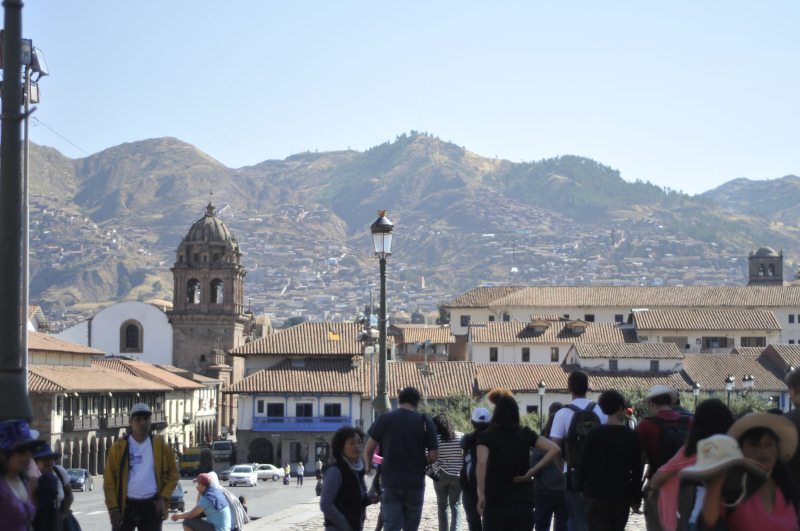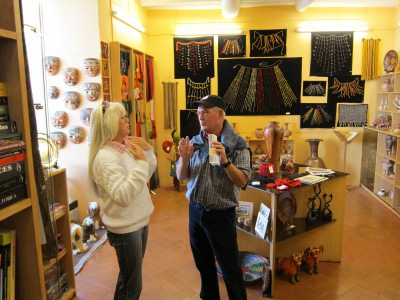Cuzco

|
Cuzco
Bottom of map is Chile, scoot north to find Cuzco
Cusco or Cuzco - in Quechua written Qusqu is a city in southeastern Peru, near the Urubamba Valley (Sacred Valley) of the Andes mountain range. It is the capital of the Cuzco Region as well as the Cuzco Province. The city has a population of nearly three hundred and fifty thousand which is triple the figure of twenty years ago, most of these people are trying to sell us something in all shapes and sizes or offering to massage us…... Located on the eastern end of the Knot of Cusco, its altitude is around eleven thousand feet. This is our first hit of altitude, dry noses, breathing a little quicker and very breathless on exertion. Cuzco is the historic capital of the Inca Empire and was declared a World Heritage Site in 1983 by UNESCO. It is a major tourist destination and receives almost a million visitors a year. It is designated as the Historical Capital by the Constitution of Peru. The city is thirteen degrees, thirty one minutes, thirty South and seventy one degrees, fifty eight minutes twenty West.

Spelling and etymology: The Spanish conquistadors adopted the Quechua name (Qosqo) for the city, but transliterated it into Spanish as Cusco. This is how it appeared on Spanish maps from the 17th and 18th centuries. On maps from the 19th century (as early as 1810) and through the mid-20th century (until at least 1976), the name appears as "Cuzco". Today, in official Peruvian cartography (in Spanish), the name has been returned to the original transliteration: Cusco, but when you look it up to book a flight it is CUZ as a code. In English, both S and Z are accepted, as there is no "official" spelling. Both British and American variants use S or Z. The Encyclopaedia Britannica uses "Cuzco". The name Cuzco is derived from the Quechua phrase, qusqu wanka (meaning "rock of the owl".) I put this S or Z bit in as we will see it all over Peru, the same with K or C. The tour books say Lake Titicaca, in the city of Puno the roads signs say Lake Titikaka. The people we have met are very proud of their Inca heritage and hang on to their traditions despite being overrun by "missionary take over", just as we have seen in the Carribean.
 
History
Killke
culture: TheKillke
occupied the region from 900 to 1200 A.D., prior to the arrival of the
Incas
in the 1200's. Carbon-14 dating of Sacsayhuaman, the walled complex
outside Cusco, had demonstrated that the Killke culture constructed the
fortress about 1100 AD. The Inca later expanded and occupied the complex in the
1200's and after. On the 13th of March 2008, archaeologists
discovered the ruins of an ancient temple,
roadway and acqueduct
system at Sacsayhuaman.
This
find plus the results of excavations in 2007, when another temple was found at
the edge of the fortress, indicated religious as well as military use of the
facility. Inca history: Cuzco was the capital of the Inca Empire (1200's-1532). Many believe that the city was planned as an effigy in the shape of a puma, a sacred animal. Under the Inca, the city had two sectors: the urin and hanan. Each were further divided to each encompass two of the four provinces, Chinchasuyu (NW), Antisuyu (NE), Qontisuyu (SW) and Collasuyu (SE). A road led from each of these quarters to the corresponding quarter of the empire. Each local leader was required to build a house in the city and live part of the year in Cuzco, but only in the quarter that corresponded to the quarter of the empire in which he had territory. After the rule of Pachacuti, when an Inca died, his title went to one son and his property was given to a corporation controlled by his other relatives (the process was called split inheritance). Each title holder had to build a new house and add new lands to the empire, in order to own the land his family needed to maintain after his death. According to Inca legend, the city was built by Sapa Inca Pachacuti, the man who transformed the Kingdom of Cuzco from a sleepy city-state into the vast empire of Tahuantinsuyu. Archaeological evidence, however, points to a slower, more organic growth of the city beginning before Pachacuti. The city was constructed according to a definite plan, and two rivers were channeled around the city. Archaeologists such as Larry Coben have suggested the city plan was replicated at other sites throughout the empire. The city fell to the sphere of Huascar in the division of the empire after the death of Huayna Capac in 1527. It was captured by the generals of Atahualpa in April 1532 during the Battle of Quipaipan. Nineteen months later, Spanish explorers invaded the city.
  Cuzco Flag and Coat of Arms
Cusco after the Spanish invasion: The first Spaniards arrived in the city on the 15th of November 1533. Francisco Pizarro officially arrived in Cuzco on the 23rd of March 1534, renaming it the "Very noble and great city of Cuzco". The many buildings constructed after the Hispanic invasion have a mixture of Spanish influence with Inca indigenous architecture, including the Santa Clara and San Blas neighborhoods. The Spanish destroyed many Inca buildings, temples and palaces. They used the remaining walls as bases for the construction of a new city. Cusco stands on layers of cultures, with the old Tawantinsuyu built on Killke structures, and the Spanish having replaced indigenous temples with Catholic churches, and palaces with mansions for the invaders. Cuzco was the center for the Spanish colonization and spread of Christianity in the Andean world. It became very prosperous thanks to agriculture, cattle raising and mining, as well as the trade with Spain. The Spanish colonists constructed many churches and convents, as well as a cathedral, university and Archbishopric. Just as the Inca built on top of Killke structures, Spanish buildings were based on the massive stone walls built by the Inca.

The first image of Cuzco in Europe. Pedro Cieza de Leon. Cronica del Peru 1553 A
major earthquake in 1950 badly destroyed the Dominican Priory and Church of
Santo Domingo, which were built on top of the impressive Coricancha
(Temple of the Sun). The city's Inca architecture, however, withstood the
earthquake. Many of the old Inca walls were at first thought to have been lost
after the earthquake, but the granite
walls of the Qoricancha were exposed, as well as those of other ancient
structures throughout the city. While some wanted to restore the buildings to
their colonial splendor, a contingent of Cusco citizens urged city officials to
retain the exposed Inca walls. Eventually they won out. (Cuzco had also been the
center of a major earthquake in 1650). Republican era: After Peru declared its independence in 1821, Cuzco maintained its importance within the administrative structure of the country. Upon independence, the government created the Department of Cuzco, maintaining authority over territory extending to the Brazilian border. Cuzco was made capital of the department; subsequently it became the most important city in the south-eastern Andean region. At the beginning of the 20th century, the city's urban sprawl spread to the neighboring districts of Santiago and Wanchaq. In 1911, the explorer Hiram Bingham used the city as a base for the expedition in which he rediscovered the ruins of Machu Picchu.
 
Alan in front of pavement repairs and negotiating in
an animated fashion in one of the many high end
shops. Honours:
In
1933, the Congress of Americanists met in La Plata, Argentina
and declared the city as the Archeological Capital of the Americas. In
1978, the 7th Convention of Mayors of Great World Cities met in Milan,
Italy
and declared Cusco a Cultural Heritage of the World. In
1983, UNESCO,
in Paris, France
declared the city a World Heritage Site.
The Peruvian Government
declared it the Tourism Capital of Peru and Cultural Heritage of the
Nation.
Present: A 1950 earthquake shook the city, causing the destruction of more than one third of the city's structures. Later, the city began to establish itself as a focal point for tourism and began to receive a greater number of tourists. Since the 1990's, tourism increased, and the hotel sector subsequently expanded. Currently, Cuzco is the most important tourist destination in Peru. The city's urban sprawl is still expanding. There are many types of eatery from café through to cordon bleu. Backpacker hostels to top rank Hotels. Shops like North Face for anything forgotten to top Peruvian labels where a Vicuña jumper is sixteen hundred US dollars.

Sights: The Spanish explorer Pizarro sacked much of the Inca city in 1535. Remains of the palace of the Incas, the Temple of the Sun and the Temple of the Virgins of the Sun still stand. In addition, Inca buildings and foundations in some cases have proved to be stronger than the foundations built in present-day Peru. Among the most noteworthy Spanish colonial buildings of the city is the Cathedral of Santo Domingo. The surrounding area, located in the Huatanay Valley, is strong in gold mining and agriculture, including corn, barley, quinoa, tea and coffee. Thanks to remodelling, Cuzco's main stadium Estadio Garcilaso de la Vega attracted more tourists during South America's continental soccer championship, the Copa America 2004 held in Peru. The stadium is home to one of the country's most successful soccer clubs, Cienciano. Cusco's local team has built a reputation in the world of club soccer, as it has won several international competitions in South America. It has yet to achieve such success in its home country. The city is served by Alejandro Velasco Astete International Airport.
ALL IN ALL A LOVELY CITY SPANISH CITY ISOLATED BY MOUNTAINS UNDER A VERY BLUE SKY
|
